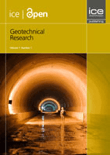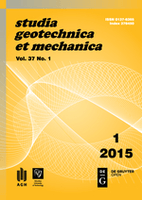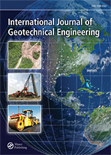
Indian Geotechnical Journal
Scope & Guideline
Advancing Geotechnical Excellence.
Introduction
Aims and Scopes
- Soil Mechanics and Behavior:
Research on the physical and mechanical properties of soils, including studies on shear strength, compressibility, and deformation behavior under various loading conditions. - Foundation Engineering:
Investigation of foundation design and performance, including shallow and deep foundations, soil-structure interaction, and innovative foundation technologies like micropiles and geosynthetic reinforcements. - Geotechnical Risk and Hazard Assessment:
Assessment of geotechnical risks, including landslide susceptibility, liquefaction potential, and seismic hazard analysis, aimed at improving safety and resilience in engineering practices. - Sustainable Geotechnical Practices:
Exploration of sustainable methods and materials in geotechnics, including the use of waste materials, bioengineering techniques, and environmentally friendly stabilization methods. - Technological Innovations in Geotechnics:
Application of advanced technologies such as machine learning, artificial intelligence, and geophysical methods in geotechnical investigations and analysis. - Field and Laboratory Testing:
Development and evaluation of testing methodologies for soil characterization and performance, including in-situ tests and laboratory experiments.
Trending and Emerging
- Machine Learning and AI in Geotechnics:
A growing trend involves the application of machine learning and artificial intelligence for predictive modeling and data analysis in geotechnical engineering, reflecting the industry's shift towards data-driven decision-making. - Sustainable and Eco-Friendly Practices:
Research focusing on sustainability, including the use of recycled materials and bioengineering approaches, is gaining traction as the field seeks to minimize environmental impact. - Seismic and Dynamic Analysis:
There is an increasing emphasis on seismic analysis and dynamic response of geotechnical structures, particularly in earthquake-prone regions, highlighting the importance of resilience in infrastructure. - Advanced Geophysical Methods:
The integration of advanced geophysical techniques for subsurface characterization and monitoring is becoming more prevalent, showing a trend towards non-invasive methods in geotechnical investigations. - Behavior of Expansive and Problematic Soils:
Research on the unique behavior and treatment of expansive soils and other problematic soils is trending, as these issues are critical in many regions of India.
Declining or Waning
- Traditional Soil Improvement Techniques:
There is a noticeable decrease in publications focusing on conventional soil improvement methods, such as lime and cement stabilization, as newer, more sustainable techniques gain popularity. - Geotechnical Applications in Non-Structural Engineering:
Research related to non-structural engineering applications, such as landscaping or site aesthetic considerations, appears to be waning as the journal increasingly emphasizes structural integrity and safety. - Basic Soil Testing Procedures:
Papers focused on standard soil testing procedures without advanced analysis or innovative approaches are becoming less common, as researchers move towards more complex methodologies. - Geotechnical Engineering for Traditional Infrastructure:
Topics related to traditional infrastructure projects, such as roads and bridges, are receiving less attention compared to specialized areas like tunneling and underground construction.
Similar Journals

Transportation Infrastructure Geotechnology
Pioneering Research in Infrastructure Sustainability and Safety.Transportation Infrastructure Geotechnology, an esteemed journal published by SpringerNature, serves as a vital platform in the fields of Civil and Structural Engineering, Environmental Engineering, Geotechnical Engineering, and Transportation. Established in 2014 and spanning a decade of significant scientific discourse, this journal has gained recognition for its robust contribution to the understanding of the interplay between geotechnical processes and transportation infrastructure. With an impactful Q2 ranking in multiple categories—including Civil and Structural Engineering and Environmental Engineering—it emphasizes innovative research and practical applications globally. Researchers and professionals can explore critical topics that influence infrastructure sustainability, safety, and efficiency. Although it operates under a subscription model, its affiliation with SpringerNature ensures rigorous peer-review and high-quality publications, making it an indispensable resource for academics and industry experts alike.

Geotechnical Research
Unlocking insights in earth sciences and engineering.Geotechnical Research is an esteemed scholarly journal published by EMERALD GROUP PUBLISHING LTD, dedicated to advancing the field of geotechnical engineering and earth sciences. With an impact factor reflective of its robust contributions, this open access journal has been providing unrestricted access to high-quality research since 2014, making it indispensable for researchers, professionals, and students alike. The journal, indexed under the ISSN 2052-6156, features rigorous peer-reviewed articles that encompass a wide range of topics within geotechnical engineering and engineering geology, achieving a notable placement in the Q2 category in both Earth and Planetary Sciences and Geotechnical Engineering as of 2023. With its Scopus ranks further affirming its significance—ranked #44 out of 159 in Earth and Planetary Sciences and #78 out of 229 in Geotechnical Engineering—Geotechnical Research stands as a vital resource for innovative solutions and advancements in this critical field, ensuring researchers access to essential insights that drive the discipline forward.

Studia Geotechnica et Mechanica
Empowering Engineers with Cutting-edge Insights and DiscoveriesStudia Geotechnica et Mechanica is a distinguished academic journal dedicated to the vital fields of geotechnics, civil engineering, and materials science. Published by SCIENDO, this Open Access journal has been facilitating unrestricted access to research since 2012, allowing for wide dissemination of innovative findings and methodologies. Based in Poland, it contributes significantly to the scholarly community by providing a platform for the exchange of ideas, techniques, and advancements relevant to Civil and Structural Engineering, Geotechnical Engineering, and related disciplines. With an increasing emphasis on applied research, Studia Geotechnica et Mechanica is classified in various quartiles, demonstrating its emerging influence in fields such as Computers in Earth Sciences and Mechanics of Materials. The journal is indexed in Scopus, showcasing its commitment to maintaining high academic standards. By publishing peer-reviewed research articles, this journal is essential for researchers, professionals, and students looking to stay at the forefront of developments in these critical areas of engineering and science.

Geomechanics and Engineering
Innovating Solutions for Tomorrow's Engineering ChallengesGeomechanics and Engineering is a premier journal published by TECHNO-PRESS that delivers high-quality research in the fields of civil and structural engineering, as well as geotechnical engineering and engineering geology. With an ISSN of 2005-307X and an E-ISSN of 2092-6219, this journal serves as a significant repository of innovative methodologies, case studies, and theoretical advancements. Located in South Korea, Geomechanics and Engineering is indexed in Scopus, where it boasts a commendable ranking of #100 out of 379 in Civil and Structural Engineering and #69 out of 229 in Geotechnical Engineering and Engineering Geology, reflecting its impact with substantial percentile rankings of 73rd and 70th, respectively. Over its converged years from 2009 to 2024, the journal aims to advance the understanding of geomechanical phenomena and their application in engineering, making it an essential read for researchers, professionals, and students committed to solving today's pressing engineering challenges.

Soils and Rocks
Innovating Solutions for Subsurface ChallengesSoils and Rocks is an academic journal dedicated to the field of Geotechnical Engineering and Engineering Geology, published by the Brazilian Association of Soil Mechanics and Geotechnical Engineering in collaboration with the Portuguese Geotechnical Society. Since becoming an Open Access platform in 2011, this journal has provided a vital publication outlet for researchers and professionals seeking to disseminate their findings on soil behavior, rock mechanics, and related topics within an international context. The journal is indexed in Scopus, holding a rank of 177 out of 229 in its category as of 2023, placing it in the 22nd percentile among its peers. Operating out of Brazil, Soils and Rocks encourages rigorous scholarly exchange and exploration of innovative practices within the sectors, making it an important resource for advancing knowledge in the geotechnical community. With a converged publication history from 2007 to 2024, the journal aims to foster significant advancements and insights that enhance our understanding of subsurface conditions and materials.

Acta Geotechnica
Shaping the Future of Geotechnical KnowledgeActa Geotechnica, published by SPRINGER HEIDELBERG, is a leading journal in the field of earth sciences and geotechnical engineering, renowned for its rigorous peer-review process and innovative research contributions. With an impressive impact factor and a notable position in the 2023 Category Quartiles as Q1 in both Earth and Planetary Sciences (miscellaneous) and Geotechnical Engineering and Engineering Geology, this journal is pivotal for professionals and academics alike, providing insights that push the boundaries of geotechnical research. The journal features a diverse range of articles, spanning from foundational studies to the latest advancements in sustainable geotechnical practices, making it an essential resource for researchers, practitioners, and students committed to understanding and solving complex geological challenges. The Scopus ranks further affirm its influence, placing it in the 95th and 92nd percentiles of its categories. With no open access options as of now, subscribers gain exclusive access to trailblazing studies aimed at enhancing geotechnical understanding and application globally.

Rock and Soil Mechanics
Connecting Global Scholars in Civil and Structural EngineeringRock and Soil Mechanics is a premier academic journal published by SCIENCE PRESS focusing on the critical fields of civil and structural engineering, geotechnical engineering, and soil science. With an ISSN of 1000-7598 and transitioning to an Open Access format since 2020, the journal strives to enhance the accessibility of cutting-edge research to a global audience, making significant contributions to practices and methodologies in these crucial disciplines. Ranked in the Q2 category for Civil and Structural Engineering as well as Geotechnical Engineering and Engineering Geology, and Soil Science, it boasts respectable standings in Scopus rankings, further affirming its relevance and credibility within the scientific community. The journal not only serves as a platform for original research but also engages with the latest advances in technology and innovative applications in rock and soil mechanics, proving invaluable for researchers, practitioners, and students alike as they navigate an increasingly complex field of study.

Geotechnical and Geological Engineering
Shaping the Landscape of Geotechnical KnowledgeGeotechnical and Geological Engineering, published by SPRINGER, is a premier journal dedicated to advancing the field of geotechnical and geological engineering. With a strong reputation demonstrated by a robust impact factor and notable Scopus rankings, the journal positions itself in the top quartile of categories such as Architecture and Geotechnical Engineering, making it an essential resource for researchers and practitioners alike. Established in 1991 and continuing through 2024, it provides a platform for original research that addresses the pivotal challenges in soil science, geology, and engineering geology. Although it does not offer open access, it remains accessible through institutional and personal subscriptions, ensuring that academic scholars, industry professionals, and students can engage with high-quality, peer-reviewed content. The journal's commitment to disseminating innovative findings and fostering interdisciplinary dialogue underscores its vital role in shaping future developments in engineering and environmental sustainability.

International Journal of Geotechnical Engineering
Exploring Innovations in Geotechnical Engineering PracticesThe International Journal of Geotechnical Engineering, published by Taylor & Francis Ltd, is a leading academic platform dedicated to advancing knowledge and research in the field of geotechnical engineering, environmental engineering, and soil science. With an ISSN of 1938-6362 and an E-ISSN of 1939-7879, this journal has established a credible presence since its inception in 2007, reflecting its commitment to academic excellence through rigorous peer-reviewed research. Ranking in the Q2 quartile across several categories—including Environmental Engineering and Geotechnical Engineering—this journal boasts impressive Scopus rankings, placing it among the top publications in its disciplines. The journal seeks to foster a deeper understanding of soil behavior, geotechnical processes, and their environmental impacts, making it an essential resource for researchers, professionals, and students alike. While it operates under a subscription model, the wealth of knowledge and innovative findings disseminated within its pages are indispensable for anyone engaged in this vital field. With an expanding focus on interdisciplinary research and practical applications, the International Journal of Geotechnical Engineering continues to play a pivotal role in shaping the future of engineering practices worldwide.

CANADIAN GEOTECHNICAL JOURNAL
Elevating Standards in Geotechnical Engineering ResearchCanadian Geotechnical Journal, published by Canadian Science Publishing, stands as a premier resource in the field of geotechnical engineering, focusing on the science and practice of soil mechanics, engineering geology, and related disciplines. Established in 1968, this esteemed journal has earned a distinguished reputation, holding a Q1 ranking in both Civil and Structural Engineering as well as Geotechnical Engineering and Engineering Geology as of 2023. It features a rigorous peer-review process that ensures the publication of high-quality research, making it essential reading for researchers, professionals, and students alike. With an impressive Scopus rank of #63 out of 379 in Civil and Structural Engineering and #41 out of 229 in Geotechnical Engineering, the journal continues to contribute significantly to the advancement of knowledge in geotechnics. While the journal does not currently provide open access options, it remains a vital platform for disseminating innovative findings and fostering academic collaboration in the geotechnical community.